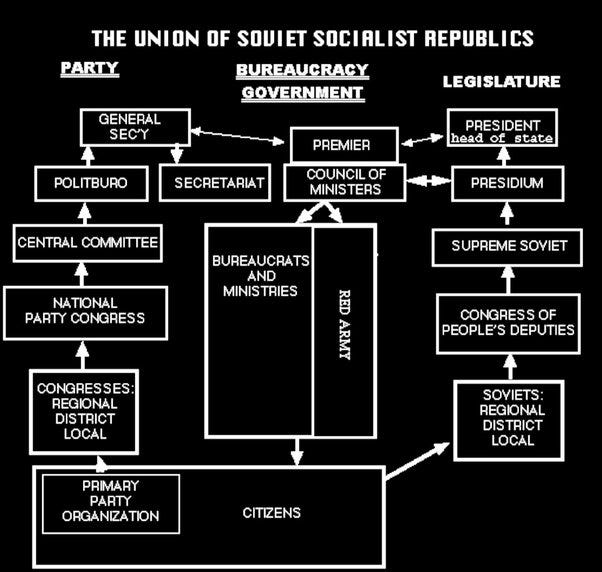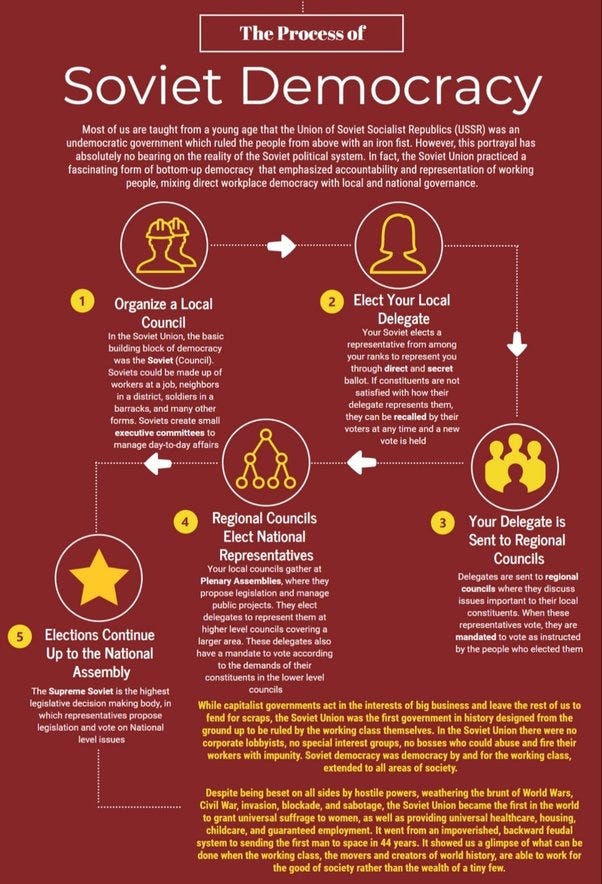Some Notes On Democratic Centralism
By Omar Elsayed (https://www.quora.com/profile/Omar-Elsayed-98)
Democracy has accompanied socialism throughout it’s history as democratic centralism. Stalin said described democratic centralism
The Sixth Congress adopted new Party Rules. These rules provided that all Party organizations shall be built on the principle of democratic centralism.
This meant :
1) That all directing bodies of the Party, from top to bottom, shall be elected;
2) That Party bodies shall give periodical accounts of their activities to their respective Party organizations;
3) That there shall be strict Party discipline and the subordination of the minority to the majority;
4) That all decisions of higher bodies shall be absolutely binding on lower bodies and on all Party members. [Source]
After the successful consolidation of power by the Communist Party following the October Revolution and the Russian Civil War, the Bolshevik leadership, including Lenin, instituted a ban on factions in the party as Resolution No. 12 of the 10th Party Congress in 1921. It was passed in the morning session on 16 March 1921. Trotskyists sometimes claim that this ban was intended to be temporary, but there is no language in the discussion at the 10th Party Congress suggesting such.
In On Party Unity, Lenin argued that democratic centralism prevents factionalism. He argued that factionalism leads to less friendly relations among members and that it can be exploited by enemies of the party.
Going to the dictatorship of the bourgeoisie, or sorry, “liberal democracy of the free world”:
But this democracy is always hemmed in by the narrow limits set by capitalist exploitation, and consequently always remains, in effect, a democracy for the minority, only for the propertied classes, only for the rich. Freedom in capitalist society always remains about the same as it was in the ancient Greek republics: freedom for the slave-owners. Owing to the conditions of capitalist exploitation, the modern wage slaves are so crushed by want and poverty that “they cannot be bothered with democracy”, “cannot be bothered with politics”; in the ordinary, peaceful course of events, the majority of the population is debarred from participation in public and political life.
Democracy for an insignificant minority, democracy for the rich–that is the democracy of capitalist society. If we look more closely into the machinery of capitalist democracy, we see everywhere, in the “petty”–supposedly petty–details of the suffrage (residential qualifications, exclusion of women, etc.), in the technique of the representative institutions, in the actual obstacles to the right of assembly (public buildings are not for “paupers”!), in the purely capitalist organization of the daily press, etc., etc.,–we see restriction after restriction upon democracy. These restrictions, exceptions, exclusions, obstacles for the poor seem slight, especially in the eyes of one who has never known want himself and has never been in close contact with the oppressed classes in their mass life (and nine out of 10, if not 99 out of 100, bourgeois publicists and politicians come under this category); but in their sum total these restrictions exclude and squeeze out the poor from politics, from active participation in democracy.
And so in capitalist society we have a democracy that is curtailed, wretched, false, a democracy only for the rich, for the minority. The dictatorship of the proletariat, the period of transition to communism, will for the first time create democracy for the people, for the majority, along with the necessary suppression of the exploiters, of the minority. Communism alone is capable of providing really complete democracy, and the more complete it is, the sooner it will become unnecessary and wither away of its own accord. [Source]
How does this democratic centralism or workers democracy work? Some of these graphic visuals may help you understand further.
Terminology
Parliamentarism: “To decide once every few years which members of the ruling class is to repress and crush the people through parliament–this is the real essence of bourgeois parliamentarism, not only in parliamentary- constitutional monarchies, but also in the most democratic republics.” [Source]
Democratic centralism: “the proletariat and the poor peasants take state power into their own hands, organize themselves quite freely in communes, and unite the action of all the communes in striking at capital, in crushing the resistance of the capitalists, and in transferring the privately-owned railways, factories, land and so on to the entire nation, to the whole of society” [Source]
Workers democracy: Workers run society and resist the return of capitalist production and reactionary ideology.





